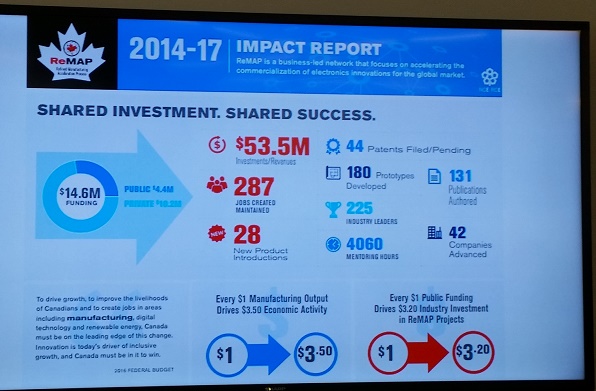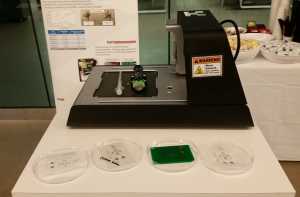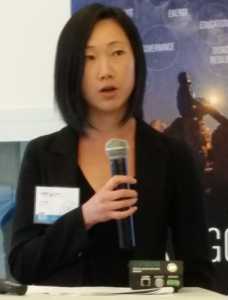Software may be eating the world, but when combined with hardware, it has potential to unleash new productive capacity, while ensuring that the fruits of invention translate to high value jobs in the region of its origin. That at least is the animus behind ReMAP, Canada’s only federally funded accelerator for advanced electronics manufacturing. Like many of the high-profile incubator programs created for the tech world, the “Refined Manufacturing Acceleration Process” (ReMAP) was established in 2014 with a mission to address the multiple issues that continue to dog the translation of good ideas to commercially viable products. However, ReMAP has evolved a unique process model that relies on “lateral innovation” and supply chain networking to support the commercialization of hardware/software electronics products, which make up the bulk of its project portfolio.

In an oblique way, ReMAP owes its origins to the world of Silicon Valley startups, which, along with several Boston area businesses, had established working relationships with a key ReMAP founding partner – Toronto-based electronics manufacturing services provider Celestica. Inspired by the outcome of these kinds of relationships, ReMAP creator and current CEO Irene Sterian was determined to deliver the same kind of support to Canadian startups, which suffered disproportionately from the “commercialization, money gap.” According to Sterian, “In Canada, startups are very well funded at the university level: the Network Centres of Excellence (NSERC) and other research organizations fund at the beginning levels, but they think a miracle will happen and they leave. Then nothing happens, and people just expect industry will adopt them [the startups]. But that just doesn’t happen.” Sterian’s goal in founding ReMAP was to bridge this gap, and specifically to secure funding to support businesses in the “Valley of Death” – Technology Readiness Levels (TRL) four to eight, where a business may have a working prototype, but to prepare for manufacture and market entry, needs to miniaturize the product, ensure quality and reduce cost so that it is globally competitive (according to the NASA framework, TRL 1 is the idea on a napkin stage; TRL 9 means the final product goes to market). “This is what’s missing in funding,” Sterian claimed, and without organizations focused on these critical stages, “Canadian ideas don’t make it to market.”
A related ReMAP goal is to help manufacturing startups scale to the point where they can create high value production jobs at a local level. In Canada, startups often sell when they have reached a much lower market capitalization than in the US, where better funded companies are able to hold on until they are more firmly entrenched in production phases. InsightaaS research has found a substantial disparity between the experience of startups in these two jurisdictions: Canadian entrepreneurs start to think about selling at the $50-$100 million, while US entrepreneurs tend to wait to see value in the $500 million or more range, and potentially into 10 figures. Beyond direct funding, project oversight and mentoring, Sterian’s team leverages the ReMAP supply chain network to help companies reach commercial scale: “One of the things that we try to do through ReMAP,” she explained, “is connect the smaller companies, the startups and the SMEs with larger companies – this seems to work well in terms of brand association.”
This networking helps smaller companies push on into production stages, while enabling established members of the supply chain make foray into new, cutting edge technology areas. Drawing on the Celestica example, Sterian argued that without support from an organization like ReMAP, a startup may not be able to afford Celestica components or manufacturing services. For its part, Celestica would see benefits from engagement in ongoing service contracts once the startup enters commercial stages, and in the opportunity to develop expertise and thought leadership in new areas through incremental involvement in relatively small projects rather than ‘all in’ investment in a new technology venture.
Funding partners such as Celestica often have unique interests, and may choose to fund certain projects that are specific to a particular market segment; but in some cases, ReMAP partners that compete on one level will all support a certain project because they have common interest in having this area explored. For example, in response to former US President Obama’s decision not to fund research into defense spending and aerospace materials, Honeywell, Rockwell Collins, BA Systems, Lougheed Martin and Curtis Right all invested in a project that is not competitive to them, and have even secured a joint patent. Sterian sees her role at ReMAP as a “matchmaker,” a facilitator that works to connect entities but also to establish market viability: “I see myself putting technology together to create a business, to create the business of technology,“ she added.
Sterian believes the real value in ReMAP lies in the network: “what is different about ReMAP is that you don’t do research and throw it over the wall. You get everybody to work together in a very compressed timeframe. Often, the research is very basic and the focus is more on the end-product, on development of processes for the global creation of prototypes or the organization of the supply chain.” In her experience, companies that engage with each other on a local level – like the company ReMAP talked out of doing its prototypes at Purdue University because it could be done in Canada – are the best hedge against Canada’s losing jobs to other global jurisdictions: “The threat with all global companies is that IP will just go to the lowest cost geography; the challenge is to create value here, and production jobs here.” In this effort, the first hurdle she described is “showing them [the startups] is that hardware is not that hard and that you can do it in Canada – there’s a supply chain here.” A second step involves education them on the benefits of exporting product directly to the US: it’s not helpful to “just go to China and export to the US from there,” she concluded. According to Sterian, “inventors are often consumed with the software side of things” and less aware of production options “in that grey zone,” the hardware-software mix for which ReMAP is uniquely qualified to help.
Sterian’s vision of a Canadian accelerator for the manufacturing segment has resonated in both public sector and private sector communities. Funded originally by the Government of Canada’s Business-led Networks of Centres of Excellence (BL-NCE) program in the amount of $7.1 million, ReMAP was required to source matching contributions from network partners – Sterian was able to raise an additional $12 million from industry partners who could see value in the ReMAP approach. Celestica provided a good deal of initial support, she added, becoming involved in multiple projects when it was not easy to find other funders. Today, ReMAP’s “product enablement ecosystem” includes 8 large industry partners, 10 research partners, 14 startups/SMEs and 20 industry associations, and leverages the resources of 38 labs and factories across Canada. It is supporting 18 projects in the new materials, optics/photonics, and renewable energy, across aerospace, defense, ICT, healthcare, industrial and renewables sectors. The organization is currently in the midst of ReMAP 2.0, its call for proposals for a next round of projects.

Partner contributions range from the delivery of direct funding to mentoring and space in incubator facilities hosted by companies such as Celestica (hardware production) INO, and CMC Microsystems, Ciena or Curtiss-Wright – “in kind” contributions that Sterian believes offer significant value: “There’s a lot of discussion now around cash in clusters, but I think ‘in kind’ contribution is just as important. For example, we have a $20 million line that we leverage for just a few hours, and we are able to pay only for the cost of the line while we are using it, as opposed to having to purchase and build the whole thing. There are some great labs, but we may only need them for one experiment – I’m against buying things for single use,” an approach to asset utilization and sharing that is not unfamiliar in the cloud-based tech world. ReMAP is recognized (by the Munk School at the University of Toronto and others) for its IP Network structures. Unlike VC incubators such as Flex in the US, ReMAP does not take an equity share in the startups it funds, and has developed infrastructure to ensure clarity around intellectual property rights, including an online flowchart featuring a drop-down menu that specifies management of existing IP, IP that is jointly developed by partner, and copywrite considerations.
Another key principle in the ReMAP approach is “lateral innovation,” a concept that describes the application of a product or idea in different contexts; for example, the chip in a bank card could be used in healthcare – placed on a surgery patient to monitor and collect data/vital signs while the individual is under anesthesia. Similarly, fibre optics have been used in telecommunications for a long time; however, they are now being deployed in medical applications, in sensors and in automotive industry (for LiDAR or light sensing). According to Sterian, there is a wide range of opportunity for lateral innovation in fibre optics: “optics and electronics combined should be everywhere,” she argued. If not everywhere, lateral creativity in the use of fibre optics, sensor technologies and materials technology was on clear display at the 2017 Commercialization Prize award ceremony held concurrently with ReMAP’s AGM this summer. Presenters from the following organizations were on hand to outline their projects and collaborative work in the ReMAP value chain.
ReMAP 08 – Indium Phosphide High Speed Modulators for optical communication systems
A project that was initiated by TeraXion, high speed modulators were conceived as a means of introducing stability in the performance of optical communications systems that may have to support regions that span up to 1,000 kilometers. To solve for cost issues that would help ensure competitiveness of the product, the team introduced automation into volume manufacturing to reduce labour costs. Developed by Ciena, which acquired TeraXion last year, the project also included McGill, CMC Microsystems and Celestica. According to team lead Carl Paquet, Ciena acquisition helped to keep project jobs in Canada. (winner of last year’s Commercialization prize and a Commercialization 2017 finalist).
ReMAP 07 Optically Guided Laser Ablation with Integrated Surgical Navigation System
Robert Xu, software developer at 7D Surgical, the company that has spun out of project 07, calls its optically guided surgical navigation system “Google Maps for Surgeons with additional smarts that draw parallels with the latest technology in computer vision and machine learning.” The platform-based machine vision, image-guided surgery tool leverages optics technologies not traditionally used in surgical navigation. The outcome is reduced operating time and costs, and an in increase in patient safety. The 7D Surgical team included Ryerson University, Sunnybrook Research Institute and Celestica, and the company has just launched marketing and sales in the US. (winner of the Global Impact Award)
ReMAP 04 Electrically Conductive Adhesives ECAs

To enable electrical connections where traditional ally solders are not feasible – for example, in flexible, bendable electronic assemblies – the ECA team is using nanomaterials, which offer several tech benefits: they offer 200 percent better connectivity than other materials, and are lowest cost while delivering the highest strength and longest shelf life. Additionally, ECAs can adhere to more than metal, and hence can be used in additive printing, an unintended but beneficial market advantage. The Project 04 team represents a collaboration between the University of Waterloo, Microbonds, Celestica, Engage Biomechanics and Juniper Networks. (a Commercialization 2017 finalist)
ReMap 011 FIBOS Advanced Optical Measurements

The collaboration between Fibos, Celestica and Ryerson University has produced a transducer (sensor) based on optical gauge amplifier technologies that delivers accurate measurements, and performs well in extreme and toxic environments, such as that found in the oil and gas industry. The team has achieved shipment of 150,000 units this year, and is developing its channel strategy to drive distribution. In recognition of the compelling business case developed by the team, ReMAP awarded the 011 project top honours in the Commercialization Prize 2017 contest. (additional $50,000 in funding to develop a competitively priced optical sensing platform that can sense in new environments)
ReMAP 010 Fibre Optics Sensors for Harsh Environments AOMS Technologies
Harsh environments create subtle pressure changes, high temperatures, radiation that can render sensors unreliable or impossible. AOMS Technologies’ Integrated Sensing Platform delivers real time 3D monitoring – essentially a 3D map of data from multi-point sensing delivered over fibre optic cable for applications that require high reliability and high stability. The hardware-software solution measures pressure, vibrations, radiation, chemicals, and temperature for customers that are concentrated in the environmental and process industries. Project partners include Celestica and McMillan-McGee, and using the reliable optical sensor solution AOMS carried out a key remediation project with the EPA.
For more detail on these and other ReMAP projects, click the ReMAP project portfolio available here.








